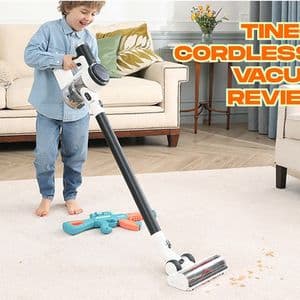Stairs are high-traffic zones. Every step sees constant pressure from shoes, pets, or even dragging items up and down. That means dirt embeds quickly into surfaces.
Unlike flat floors, stairs have narrow edges, vertical risers, and corners where dust gathers. This creates a challenge for upright or canister vacuums that lack flexibility. A handheld vacuum solves this by combining portability with targeted suction.
Benefits of Using a Handheld Vacuum for Stairs
A handheld design offers freedom of movement. You don’t need to drag heavy equipment up and down each step. Instead, you can clean one section at a time with less strain.
These vacuums also come with specialized attachments. Crevice tools reach into corners, while brush heads work on upholstery or carpeted steps. This versatility makes them ideal for households with pets, children, or frequent stair use.
Features to Look for in a Handheld Stair Vacuum
When choosing a stair-friendly vacuum, a few key elements matter most:
1. Weight and Portability
A lightweight body is essential for extended use. Lugging a heavy machine can cause fatigue, especially on tall staircases.
2. Battery Life and Power
Cordless models offer greater mobility, but they rely on strong batteries. Look for designs that balance runtime with suction power for consistent performance.
3. Suction Strength
Stairs tend to trap fine dust and hair. A vacuum with adjustable suction ensures you can switch between quick pickups and deeper cleaning.
4. Attachments
Brushes, crevice tools, and motorized rollers expand cleaning options. These make it possible to handle different stair materials, from wood to carpet.
Cleaning Carpeted Stairs with a Handheld Vacuum
Carpeted steps are a dust magnet. Fibers trap dirt, and daily foot traffic forces debris deeper. Here, using the best handheld vacuum for carpeted stairs can make a significant difference.
Start by tackling the edges with a crevice tool. Then, switch to a brush attachment to agitate fibers and loosen dirt. Work methodically—step by step—for the most thorough results.
How to Maintain Wooden Stairs with a Handheld Vacuum
Wooden stairs require gentle care. Excessive suction or rough attachments may scratch the surface. Use soft brush heads or fabric-friendly tools instead.
Be sure to vacuum along the corners where dust collects. Follow up with a microfiber cloth to catch any remaining fine particles.
Read more: Best Handheld Vacuum for Stairs
Tips for Effective Stair Cleaning
Clean from Top to Bottom
Always start at the top of the staircase and work downward. This prevents dust from falling onto already-cleaned steps.
Use Short Sessions
Instead of cleaning all stairs at once, try quick bursts. This helps avoid fatigue and makes vacuuming less of a chore.
Empty the Dustbin Regularly
Handheld vacuums have smaller dust containers. Emptying them frequently ensures steady suction power.
Alternatives to Handheld Vacuums
While a handheld unit is often the easiest, some households prefer a small vacuum for stairs that offers additional capacity. Compact stick models or lightweight uprights can also serve this purpose if portability remains a priority.
Safety Considerations
Cleaning stairs involves movement and balance. Always keep one hand steady, avoid overreaching, and make sure the vacuum cord (if applicable) doesn’t create a tripping hazard.
For cordless models, ensure batteries are fully charged before starting so you won’t need to stop mid-cleaning.
Final Thoughts
A handheld vacuum cleaner for stairs is more than just a convenience—it’s a practical solution to one of the toughest cleaning challenges at home. By focusing on portability, suction strength, and proper attachments, you can keep both carpeted and wooden stairs free of dirt and dust.
Remember, the right tools don’t just make cleaning faster; they also make it more effective. Whether you’re battling pet hair, everyday debris, or simply want a neater home, handheld vacuums give you the flexibility you need to maintain spotless stairs.










